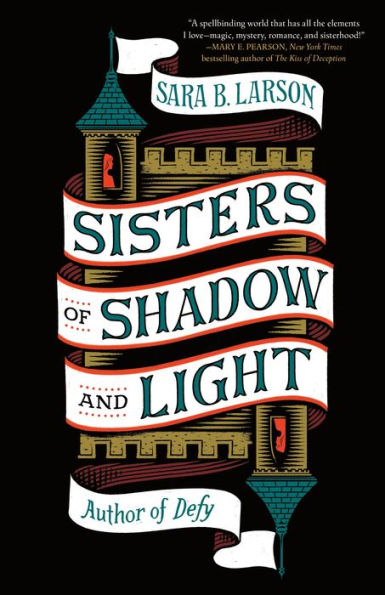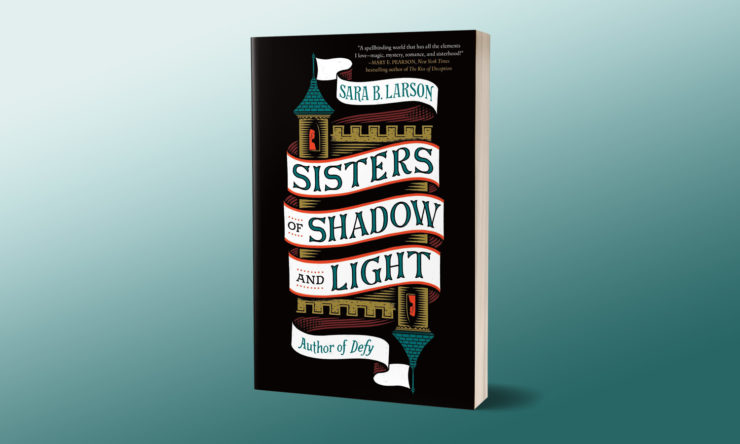Inara and Zuhra have been raised by their cold, unfeeling mother, trapped inside the Citadel of the Paladin’s, surrounded by a sentient hedge that won’t let them out—or anyone in. They don’t know much about who they are or why they’re there, though Zuhra has figured out that their father was a magical Paladin who abandoned his family the night Inara—with her obviously Paladin power filled bright blue glowing eyes—was born. The history of the Paladins, or why the local villagers fear and hate them, is not fully understood by the girls, though they live in what was once an active Paladin fortress, filled with remnants of a reign that has mysteriously vanished into what was once a connected world. Things plod along with the sisters, but when a stranger comes to town and the hedge lets him in, Zuhra can’t help but wonder if this young man is there to save them—with information and knowledge, if nothing else.
Sara B Larson’s new novel Sisters of Shadow and Light wants to be so much more than it ultimately—unfortunately—manages to be. It wants to be a story about the bond between sisters, about their loyalty and fierce defence of each other, about their shared traumas and anxieties, and about how they help each other heal and move forward. But the story itself is fairly formulaic, as is the setting, which seems quite standard for a medieval Eurocentric fantasy—there are inns, a village with a midwife, very Aryan magical beings of various powers, that citadel surrounded by a wall-like hedge (keeping people out or keeping residents of the citadel in?); the female characters dress in skirts and blouses or lace edged dresses, and everyone appears to be fair skinned and blue or green eyed, if not blonde. It’s all just rather…familiar.
But the two lead female characters are called Zuhra and Inara—both common Arabic origin names currently still used in Islamic countries, but with no explanation why those names would be chosen in what is ostensibly some sort of medieval fantasy world. The girls’ father is part of a people called the Paladin—conventionally Eurocentric knights, fine, but the monsters they fight are called rakasa, which is much too close to the Hindu rakshasa to sit comfortable in this context. Is it simply a matter of random, ‘diverse’ naming conventions with no substance behind the use of ‘diverse’ sounding names? Is it a matter of mixed up mythologies that don’t traditionally intersect? Each of these discrepancies act as roadblocks in the narrative, slamming a reader up against a wall each time they appear.
Even within fantasy narratives there are histories and fixed timelines in those histories, but no matter—some willing readers may suspend disbelief for all this with ease (or possibly not know better), while other more discerning ones will not be as forgiving.
Buy the Book


Sisters of Shadow and Light
The sisters themselves, as much as Larson wants them each to be unique, sound very similar, and are just not terribly interesting or well developed—the one thing that defines each is her huge love for the other. They’ve grown up alone, with no one around them for fifteen years, other than their cold mother and the midwife from the village who came to help at the birth of the second daughter and never really left (she has her own emotional baggage also to do with her own sister—it seems like quite a few characters do, actually) , so it’s understandable that Zuhra and Inara are so co-dependent—they are literally all they have ever known. But this does make them a little less interesting, since we don’t really get a sense of much else about them, especially Inara, who is consumed by the Paladin power she was born with, so much so that it is a constant ‘roar’ inside her mind, reducing her to large spates of uncontrollable physical jerking, repetitive nonsensical speech and an inability to communicate. She has only brief moments of lucidity when she manages to leak some power away into helping her plants grow, so she can only explain what is happening to her during those brief moments, and is entirely dependant on Zuhra to keep her safe at all other times, even within the Citadel walls.
For two young women who have had to depend solely on each other and have never so much as met someone of the opposite gender before (their father having vanished at Inara’s birth, when Zuhra was three), they seem to have very little suspicion for the first man they do meet. It really isn’t clear how much the girls know of the world outside, or why they don’t know more, or what their level of exposure has been (via their mother or Mahsami the midwife turned housekeeper, both of whim lived half their lives outside the Citadel), but Zuhra finds herself unable to not admire the physical attributes of every young man she encounters, which seems a little odd, not to mention unnecessary to the story or plot. Perhaps this can be explained away by her Mother’s attitude of trying to prepare her for some sort of traditional marriage (though why her mother thinks marriage to a suitable young man is inevitable from within the confines of a poison hedge barricaded fortress is yet another mystery, even to Zuhra). There are quite a few melodramatic damsel in distress moments too, far too many to be out weighed by the brief moments when the female characters have agency.
Perhaps some readers in the lower end of the ages 12 and up category will be less discerning about the confusions that plod around in Sisters of Shadow and Light. Perhaps even 12 year olds from parts of the world where names like Zuhra and Inara are recognisable, where rakasa will be easily assumed to be the more familiar rakshasas will wonder why these mythological crossovers exist—or what they mean, if they are conscious decisions. Sisters of Shadow and Light could be so much more if, like it’s two lead characters, it could just figure out who it really was.
Sisters of Shadow and Light is available from Tor Teen.
Mahvesh loves dystopian fiction & appropriately lives in Karachi, Pakistan. She writes about stories & interviews writers the Tor.com podcast Midnight in Karachi when not wasting much too much time on Twitter.










